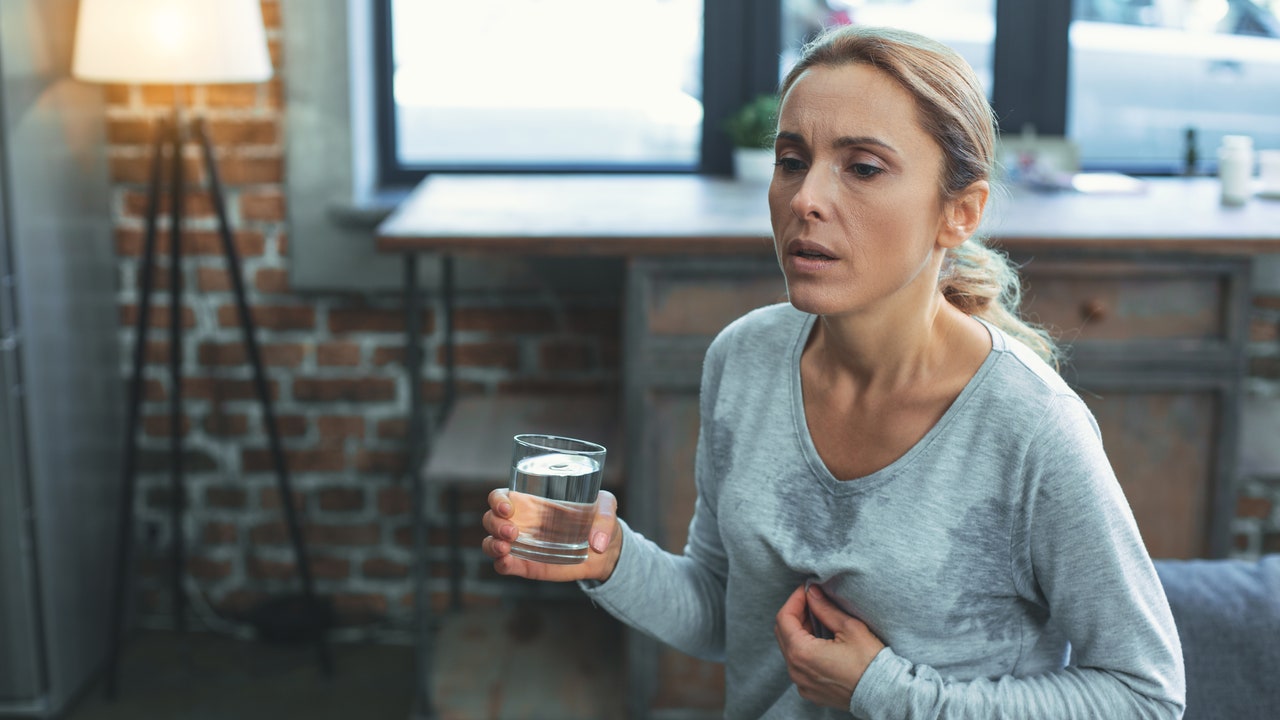What Does a Hot Flash Feel Like?

[ad_1]
Menopause can sometimes feel like it’s shrouded in mystery. At what age will it all begin? What does a hot flash feel like? Do we really need to call it “the change”? So many questions.
While 1.3 million women become menopausal in the U.S. each year, it can still feel like the great unknown. A time when your monthly periods come to an end, hormones change, and you experience hot flashes. It’s a fact of life. You might have heard your mother describe hot flashes to you or seen it alluded to on The Golden Girls (can we have more coverage of menopausal women, please!?), but how do they really feel?
We asked medical doctors about what a hot flash feels like and had them break down one of the most common symptoms of menopause.
What are hot flashes?
In the U.S., the average age women reach menopause is 51—approximately 5% of women experience early menopause between the ages of 40 and 45. According to research journal BMC Women’s Health, some of the most common menopausal symptoms include night sweats, insomnia, vaginal dryness, mood disorders, weight gain, and hot flashes.
A hot flash, sometimes called a hot flush, is one of the most common symptoms of menopause. “Hot flashes are a result of an exaggerated but temporary hormonal response of our body’s thermoregulator in our brain—the hypothalamus—that leads to a paradoxical dilation of the blood vessels in our skin, thus causing a rush of blood to the surface of our skin,” says Cindy M.P. Duke, M.D., Ph.D., FACOG. “This in turn leads to us feeling suddenly warm and flushed.”
Not all women will experience hot flashes. Hot flashes affect approximately 85% of menopausal women. Around 55% of women experience hot flashes as they transition into the menopause stage.
What do hot flashes feel like?
Menopause affects everybody differently, and so hot flushes can feel different from individual to individual. “Many women describe a hot flash as a sudden onset of heat that is felt internally especially in the chest, neck, and face,” says Kiarra King, M.D., a board-certified ob-gyn. “Some women will have associated perspiration, flushing, or heart palpitations.” According to a review in the Journal of Midlife Health, hot flashes are sensations of heat, sweating, flushing, anxiety, and chills.
If “the change” isn’t enough menopause lingo for you, King has another one. “Hot flashes have been nicknamed ‘personal summers’ by many women,” she says.
How long do hot flashes last?
Now that you know what hot flashes feel like, you might be wondering, “How long do I have to go through this?” According to King, “Hot flashes usually last for less than five minutes.” That’s right. The time it takes to go for a quick jog around the block, phone a friend, or start reading the classic you promised to read for book club.
But if you’re curious as to how long you’ll have to deal with hot flashes, it varies. A multiracial, multiethnic study of menopausal women across the U.S. found that the median total duration of hot flashes was 7.4 years.
Can you control hot flashes?
In some cases, when hot flashes are too frequent or uncomfortable, hormone therapy might be an option. “As hot flashes occur in response to fluctuations in estrogen levels and the brain’s own response in trying to talk to your ovaries to get them to make more estrogen, hormone therapy can effectively treat [and/or] eliminate hot flashes,” says Duke.
Tips to reduce hot flashes
Depending on your level of tolerance and the frequency and intensity of symptoms, you might not need ways to manage your hot flashes. “It generally depends on how the hot flashes are impacting a woman’s quality of life,” says King. “If a woman has only one or two hot flashes per day, she may not be seeking any type of relief. If the hot flashes are significantly affecting a woman’s daily activities, it may be time to take action.” If you fall into the latter camp, there are nonhormonal ways to manage hot flashes. Here are six key tips to managing symptoms.
1. Dress in layers.
This is an easy one. When you get ready for your day, give yourself the chance to cool off by dressing in layers. That way, when a hot flash strikes, you can simply remove a sweater or jacket.
2. Carry a personal fan.
Sometimes hot flashes can strike when you’re out and about. Slipping a small paper or electric fan into your bag can help to provide some relief while experiencing a hot flash in an environment where you can’t easily control the temperature.
3. Limit hot beverages.
This might seem like a fairly straightforward approach, but for the java lovers, it can be tricky to turn away from that morning cup of coffee, which can raise your body temperature. Fortunately, you can simply switch them out with iced beverages instead.
4. Limit alcohol intake.
Alcohol can dilate or relax blood vessels. This can in turn cause a person to feel warmer due to heat being lost through the skin. So use the hot flashes as an excuse to cut back on the merrymaking.
5. Maintain a lower room temperature than usual.
If you’re experiencing menopausal symptoms more so at night, it helps to keep the thermostat in a range that won’t add to your discomfort throughout the evening. Get yourself some rest!
6. See your doctor.
There may be options to help alleviate hot flashes and other bothersome symptoms of menopause, such as vaginal dryness. Depending on your medical history, you might be a candidate for hormone replacement therapy (HRT) or other medications geared toward a symptomatic reduction in hot flashes.
[ad_2]
Source link




